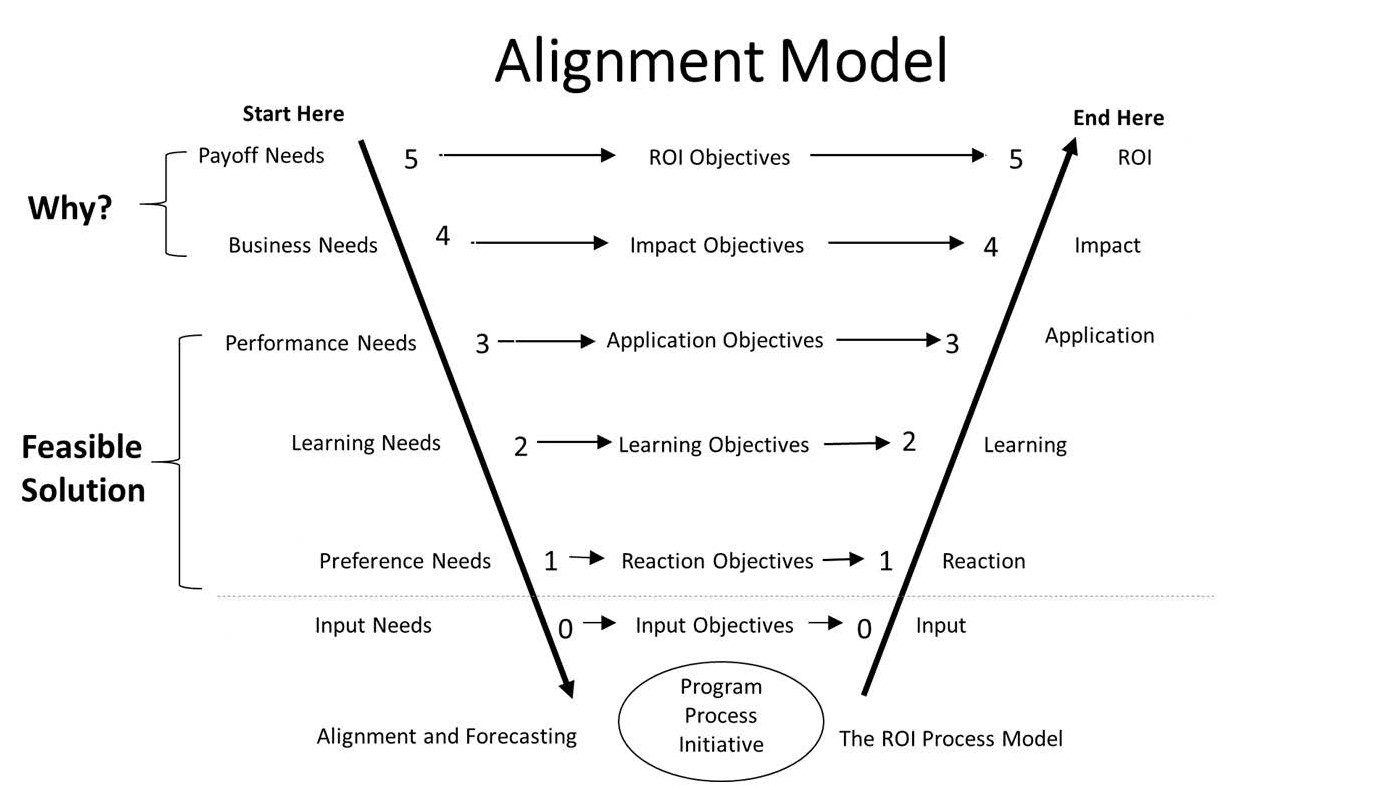Your cart is currently empty!
Start Where You Want to Finish: Aligning Soft Skills to Business
Patti P. Phillips, Ph.D., and Jack J. Phillips, Ph.D.
This article was originally published March 22, 2021, on Talent Management, ChiefLearningOfficer.com.
One of the most elusive issues for today’s evaluation team is how do you align soft skills programs to business measures. Can something as soft as empathy, communications, critical thinking, or inclusiveness be connected to the business? We know executives want all programs to connect to the business. This leaves many people asking, how do soft skills connect to the business? The key issue for this type of evaluation is to start with the end in mind or ask, where do you want to finish? That end shouldn’t necessarily be a behavior, but the impact on a business measure.
It helps to visualize this, and Figure 1 illustrates an alignment model showing how data are aligned in a typical program. On the right side of the model are the classic levels of outcomes that are the basis of most evaluation systems as an evaluation moves from reaction to learning, and to application, impact, and ROI. These data sets are driven by objectives (in the middle) set at those levels (reaction, learning, application, impact, and ROI). These objectives are developed from the needs identified at each level (on the left side), beginning with payoff needs, moving to business needs, performance needs, learning needs, and preference needs.
Figure 1. The Alignment Model

Why Programs Are Initiated
It is helpful to reflect on how programs are initiated. Did someone request it? Is there an obvious problem that needs to be solved? Is this a trend in organizations? Or is there a best-selling book written about this? Sometimes an analysis will reveal the need for the program. Understanding what initiates programs helps you understand your approach to connecting it to the business.
Start with Why
A fundamental issue with many programs is the question, is it worth it? If the program is solving a problem, is it a problem worth solving? If it is addressing an opportunity, is this an opportunity worth pursuing. Business measures can clearly describe a problem or opportunity. Sometimes it’s an obvious problem, such as turnover is too high, complaints are excessive, or it takes too long for a process(time). At other times, it’s not so clear that there is an obvious opportunity. For example, if a program is implemented at the request of an executive, why is it being requested? Has some analysis revealed a need? Or, is it something others are doing? These situations will require some discussion and, perhaps more analysis. There are three options to take in making this alignment:
Connect to Overall Business Measures
In some situations, there is a clear business measure, such as excessive turnover of critical talent, inadequate customer service, excessive discrimination complaints by employees, excessive unplanned absenteeism, or a decline in productivity. In those cases, if the solution is aimed at driving all (or some of) those measures, they need to be clearly defined. For example, in a recent conversation with the talent development team at a large railroad system, the executives wanted a leadership program because there were excessive turnovers, accidents, and grievances. You may need to validate the clear linkage to the program. It is assumed that these measures are excessive across the organization, and all the participating leaders have these specific measures.
Allow the Participants to Select the Measure
A program is being implemented on inclusive leadership, and participants are asked to think about their team’s performance measures, often called key performance indicators (KPIs). They should identify two measures that need to be improved by the team, using the planned competencies in the program. This is usually not difficult because soft skills are often powerful, flexible, and versatile. If implemented correctly, they can have an impact and improve the measures that need to change. With this approach, each participant has identified two business measures (with two impact objectives) that are clearly linked to the program. This is why they are involved in the program.
Partner with the Manager
If participants in a Crucial Conversations program are having difficulty connecting this program to a business measure, the manager may be able to help. It may require conversations about why this skill is needed and what would happen if crucial conversations are not conducted. This usually leads to productivity decreases (output), errors increasing (quality), or it takes too long to accomplish tasks or procedures (time). Together, the manager and the participant could identify a particular impact measure in the system that will probably deteriorate if they don’t use the skill. These conversations are important because the impact measures are usually KPIs for the manager, which is a way to secure manager interest and support.
Is it the Right Solution?
Analyze the Situation
Sometimes, making sure the program is the right solution involves a discussion, some analysis, or maybe both. Suppose there is an excessive number of unplanned absences, turnovers of critical talent, transfers, accidents, incidents, or customer complaints. If those are the problems, then some analysis may be needed to understand what is causing the problem. Essentially, this moves from a business need to a performance need, trying to find the answer to the question, what should we be doing differently in the workplace to improve the business measure (performance needs)? The answer to this question identifies the solution and establishes a specific impact objective for the participants.
Have a Discussion
In some cases, a discussion with the program’s requestor may be appropriate, which involves a dialogue about the business need’s focus. This conversation can go down the left side of the alignment model as we try to understand what is inhibiting the impact measure. The discussion should encourage the requestor to answer the question: What should we do differently to improve that business measure?
The other approach is to go up the left side of the alignment model, starting with the proposed soft skill solution. We could then ask, do they know these particular skills? Are they using the skills now? Then, we continue to move up the left side and say that if they use this skill routinely in their work, what impact will it have in their work. What measure will change? Persistence can pay off by continually focusing on so what?
Imagine if you conducted a Crucial Conversations workshop and reported that now 80 percent of the team is having crucial conversations in appropriate situations at appropriate times. A curious question from the executive team perspective would be; that’s great, but how did that help our organization? It is natural to ask about the impact of having these conversations. These discussions may need to involve others who know more about the situation than the requestor does.
Use Evaluation as a Hook
The discussion might also involve using evaluation as a hook. On the right side of the model, ask, where would you like to evaluate this program when it’s complete? Most requestors (if they are at the manager or executive level) will want to see the impact and might be intrigued with the ROI. Of course, to get to the ROI, you need impact because impact data is converted to money to compare to the cost of the program to yield the ROI. That request leads you quickly to an impact objective. The impact objective comes from the business need. You need to understand this business need clearly.
This discussion might be uncomfortable for some, but it follows a routine, systematic, performance consulting line of questions. In this role, you are acting as a performance consultant to help this executive (or program requestor) to connect this program to the business.
Expect Success
After the business need is identified (start with why) and the solution is selected, the objectives are set for reaction, learning, application, and impact levels. Objectives provide the focus needed to drive the business measures. The designers, developers, participants, managers of the participants, the program owners, and the facilitators focus on success at the impact level. Remember, the impact is desired by the executives and it explains why you are pursuing this program. The reason for the program is not to learn, or use, a soft skill but to improve an impact measure that the soft skill can influence.
The Rest of the Story
When this step is taken, it is just a matter of measuring for impact, sorting out the effects of the program on the impact from other influences, converting this data to money, and then comparing the monetary benefits to the cost of the program. For an example of how this is accomplished, please drop us a note. We can send you a case study illustrating how a learning program on empathetic and inclusive leadership started with the end in mind and was designed to deliver the results. It’s a shift in mindset, and it’s important and needed. If you have questions, please let us know.


























